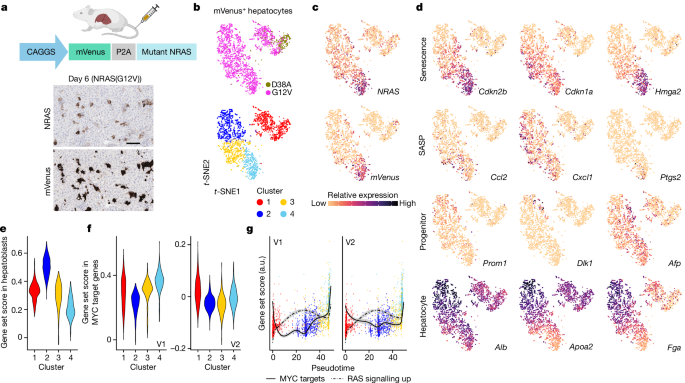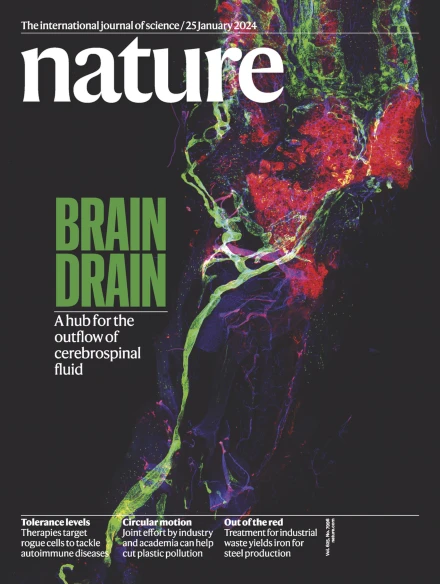RAS 的滴定会改变衰老状态并影响肿瘤的发生。
IF 50.5
1区 综合性期刊
Q1 MULTIDISCIPLINARY SCIENCES
引用次数: 0
摘要
致癌 RAS 诱导衰老(OIS)是一种与恶性肿瘤前期相关的自主肿瘤抑制机制1,2。实现这种表型通常需要高水平的致癌压力,但较低致癌剂量引发的表型仍不清楚。在这里,我们在体外和体内建立了致癌 RAS 剂量递增模型,揭示了 RAS 剂量驱动的非线性连续下游表型。在体内肝细胞OIS模型中,异位表达NRAS(G12V)不会诱发肿瘤,部分原因是OIS驱动的免疫清除3。单细胞 RNA 测序分析显示,不同的肝细胞群具有典型的 OIS 或祖细胞样特征,分别对应于高水平和中等水平的 NRAS(G12V)。当滴度降低时,NRAS(G12V)表达的肝细胞会产生免疫抵抗并发展成肿瘤。单细胞分辨率的时间序列监测确定了两种不同的肿瘤类型:早发侵袭性未分化型和晚发分化型肝细胞癌。每种小鼠肿瘤类型的分子特征都与不同的祖细胞特征有关,并富含不同的人类肝细胞癌亚类。我们的研究结果定义了致癌剂量驱动的OIS谱系,调和了早期肿瘤发生过程中的衰老和肿瘤发生表型。本文章由计算机程序翻译,如有差异,请以英文原文为准。


Titration of RAS alters senescent state and influences tumour initiation
Oncogenic RAS-induced senescence (OIS) is an autonomous tumour suppressor mechanism associated with premalignancy1,2. Achieving this phenotype typically requires a high level of oncogenic stress, yet the phenotype provoked by lower oncogenic dosage remains unclear. Here we develop oncogenic RAS dose-escalation models in vitro and in vivo, revealing a RAS dose-driven non-linear continuum of downstream phenotypes. In a hepatocyte OIS model in vivo, ectopic expression of NRAS(G12V) does not induce tumours, in part owing to OIS-driven immune clearance3. Single-cell RNA sequencing analyses reveal distinct hepatocyte clusters with typical OIS or progenitor-like features, corresponding to high and intermediate levels of NRAS(G12V), respectively. When titred down, NRAS(G12V)-expressing hepatocytes become immune resistant and develop tumours. Time-series monitoring at single-cell resolution identifies two distinct tumour types: early-onset aggressive undifferentiated and late-onset differentiated hepatocellular carcinoma. The molecular signature of each mouse tumour type is associated with different progenitor features and enriched in distinct human hepatocellular carcinoma subclasses. Our results define the oncogenic dosage-driven OIS spectrum, reconciling the senescence and tumour initiation phenotypes in early tumorigenesis. Oncogenic RAS dose-escalation models are used to explore how the level of RAS determines whether cells enter a senescent state or have tumour-initiating activity.
求助全文
通过发布文献求助,成功后即可免费获取论文全文。
去求助
来源期刊

Nature
综合性期刊-综合性期刊
CiteScore
90.00
自引率
1.20%
发文量
3652
审稿时长
3 months
期刊介绍:
Nature is a prestigious international journal that publishes peer-reviewed research in various scientific and technological fields. The selection of articles is based on criteria such as originality, importance, interdisciplinary relevance, timeliness, accessibility, elegance, and surprising conclusions. In addition to showcasing significant scientific advances, Nature delivers rapid, authoritative, insightful news, and interpretation of current and upcoming trends impacting science, scientists, and the broader public. The journal serves a dual purpose: firstly, to promptly share noteworthy scientific advances and foster discussions among scientists, and secondly, to ensure the swift dissemination of scientific results globally, emphasizing their significance for knowledge, culture, and daily life.
 求助内容:
求助内容: 应助结果提醒方式:
应助结果提醒方式:


